2019 Second Quarter in Review
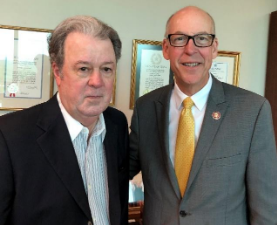
JOHN GOODMAN AND REP. GREG WALDEN DISCUSS THE REPUBLICAN RESOLUTION ON PRE-EXISTING CONDITIONS.
In an ideal world, most people would own their own health insurance and take it with them as they travel from job to job and in and out of the labor market. Some employers might have better insurance than people can find in the open market. But most employers would prefer to make a cash contribution to help employees pay their own premiums in lieu of providing insurance directly.
As explained in John Goodman’s recent post at Forbes, the Trump Administration is making that happen. Beginning next January, employers will be able to help employees obtain their own coverage with pre-tax dollars.
The Goodman Institute has promoted this idea in many forums – in editorials, in publications, in legislation and in advice to members of Congress. Along with our friends at the Independent Institute, we were the only think tank that did that.
In the last several years, the only Republican plan to reform Obamacare that included personal and portable insurance was a bill sponsored by House Rules Committee Chairman Pete Sessions and Sen. Bill Cassidy (with large input from John Goodman). Reforms endorsed by the Republican leadership consistently ignored this idea. Clearly the president is leading, while Congress follows or acquiesces.
Study: Tax Law is More Progressive Because of Tax Reform
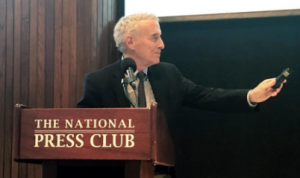
LAURENCE KOTLIKOFF SPEAKS TO THE NATIONAL TAX ASSOCIATION AT THE NATIONAL PRESS CLUB IN WASHINGTON, D.C.
What share of the tax cuts went to the rich and the poor? The richest 1% received 9.3% of the total tax cuts, but they were previously paying 30.2% of all the taxes. The top 20% received 52.2% of the tax cuts, but they were previously paying 80.1% of the taxes. The bottom 20% got 3.3% of the tax cuts. But previously they were not paying taxes at all. In fact, they were receiving a 9.0% “refund.”
This Goodman Institute-supported study by Laurence Kotlikoff, Alan Auerbach and Darryl Koehler bent over backwards to give the critics the benefit of the doubt by assuming that all the benefits of lower corporate taxes go to shareholders. If we accept Kotlikoff’s findings that the benefits mainly go to labor, tax reform is even more progressive than the results reported here.
Study: State and Local Taxes Will Hurt a Lot More
Governors of high tax states are right to be concerned about the effects of tax reform on their state’s economic future. A new study shows that the benefits of tax reform vary widely – and state taxes are the most important reason.
The study was produced by Goodman Institute Senior Fellow Laurence Kotlikoff and his colleagues and is available as a Federal Reserve Bank of Atlanta Working Paper. It concludes that:
- The average household in America can expect a lifetime gain of $25,322 from the tax reform law, measured in current dollars.
- The gain varies from a high of $40,998 in Washington State to a low of $17,888 in Vermont.
- The most important reason for differences among the states is a new, $10,000 limit on the deductibility of state and local taxes.
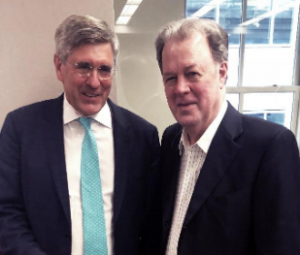
JOHN GOODMAN AND STEVE MOORE AT THE TAX CUT WORKING GROUP MEETING IN WASHINGTON, D.C.
These estimates are for the effects of tax reform alone and do not include the effects of a larger economy. In other work, Kotlikoff estimates that economic expansion spurred by the reform will more than double the benefit for most people.
The study is a first-of-its-kind estimate of the lifetime effects of the state-level impact of the new tax law – projecting how individuals will fare, right up through their retirement years. The study not only estimates how state and federal taxes interact for people at different ages and income levels, it also estimates how the changes will interact with Social Security, Medicare and roughly 30 federal entitlement programs.
State taxes are the main reason why residents of some states have two to three times the gains of households in other states. For example:
- Among the ten states where the average household has the highest gain as a percent of lifetime income, seven have no state income tax.
- By contrast, the five states where the average household gets the lowest benefit from tax reform have some of the county’s highest state income tax rates.
In California, where income can be taxed at a top rate of 13.3%, the gain from tax reform for the average household is $21,548. In Texas, with no income tax, the gain is $31,124. However, if there were no limit on the deductibility of state and local taxes, Californians would have done better than Texans under the new law.
The study also finds a weak relationship between how residents fare under the new tax and how the state tends to vote in presidential elections. On average, people did better in states that tend to vote Republican and worse in states that vote Democrat. For example:
- Among the 12 states where the average household has the smallest gain from tax reform, 10 are reliably blue states in presidential elections.
- Among the 10 states where the average household had the highest gains from tax reform, half are reliably red states in presidential elections.
GOP Extends Our Health Care Resolution
Republicans are getting killed on the pre-existing conditions issue. Arguably, it’s why the Democrats won the House.
The best answer: a House resolution we helped prepare last year. It pledged that in any reform of Obamacare the states would be given broad authority to clean up their individual markets, provided that insurance in those states gets better for people with health problems.
Better insurance means lower premiums, lower deductibles and broader networks – with the ultimate goal of insuring that people who leave their employer plans can find insurance that is comparable in cost, quality and access to care in the individual market.
Greg Walden (R-OR) and Kevin Brady (R-TX) introduced a new version of that resolution in the spring. And in April, Walden met with Goodman Institute President John Goodman and former Rules Committee Chairman, Pete Sessions, to discuss ways of making the resolution stronger.
Kotlikoff on Global Warming
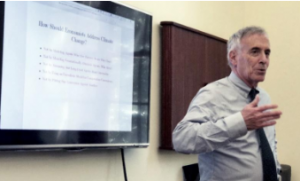
LAURENCE KOTLIKOFF PRESENTS THE RESULTS OF A NEW GLOBAL WARMING STUDY AT THE ENVIRONMENTAL PROTECTION AGENCY IN WASHINGTON, D.C.
Economists are almost unanimous about one thing. If there is a need to limit carbon emissions, there is only one right way to do it: a carbon tax. That will limit emissions but give everyone financial incentives to find the least costly way to do it.
Environmentalists, almost to a one, think of this policy option as the current generation sacrificing so that future generations can have a more comfortable life.
A new NBER Working Paper by Kotlikoff, Jeffrey Sachs and others accepts the idea of a carbon tax, but has a new twist on who should pay it.
Instead of the current generations sacrificing so that future generations can enjoy a better world, they argue that future generations should compensate us for the sacrifice and then some.
In this way, every generation gains from a carbon tax – not just our great grandchildren.
Pirie on Brexit

MADSEN PIRIE ANALYZES BREXIT FOR THE WORLD AFFAIRS COUNCIL OF DALLAS/FORT WORTH.
The Goodman Institute and the World Affairs Council of Dallas/Fort Worth sponsored a presentation in May on Brexit by Madsen Pirie, president of the Adam Smith Institute in London and long-time advisor to Conservative Party politicians in Britain.
Pirie and John Goodman first met at a Windsor Castle conference in the early 1980s. Margaret Thatcher was Prime Minister. Ronald Reagan was President. The world was rapidly changing. Goodman persuaded Pirie to write a short book on Thatcher’s 21 techniques of privatization and Goodman published them. They were short and simple: If you can sell it, sell it. If you can’t sell the whole, sell a part. If you can’t sell any of it, give it away. . . . And so forth.
At the event in Dallas, Pirie correctly predicted that the new Brexit party would get a commanding share of the votes for representation in the European Parliament. He also predicted that Boris Johnson would be the odds-on favorite to replace Theresa May as leader of the Conservative Party.
Pirie predicts that withdrawal from the European Union will cause short term economic pain, but not long-term harm – as Britain charts its own course in the future.
Trump Is Following Our Recommendations on Medicare Reform
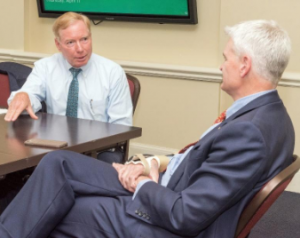
GOODMAN INSTITUTE BOARD MEMBER LAWRENCE WEDEKIND TALKS WITH SEN. BILL CASSIDY AT THE ORGANIZATION’S BOARD MEETING IN WASHINGTON, D.C.
Following a meeting with Seema Verma (who runs Medicare and Medicaid) and her staff, John Goodman and Goodman Institute board member Lawrence Wedekind described the Trump Administration’s Medicare reforms in a post at the Health Affairs Blog.
This may be the first time in print that anyone has revealed that 10.4 million Medicare enrollees who think they are in a traditional fee-for-service plan are actually in an HMO-type plan, where providers have an economic incentive to provide less care. Worse: Obama Administration rules made it illegal for doctors to tell their patients about it.
The Obamacare-created plans are called Accountable Care Organizations (ACOs). They contrast with Medicare Advantage (MA) plans, which have enrolled more than one-third of the Medicare population and which compete against each other and against traditional Medicare. Seniors enrolled in MA plans know they may face restrictive networks and they understand the economic incentives of their insurer. But they benefit from transparent competition.
Goodman and Wedekind call President Obama’s ACOs an attempt at “stealth privatization.” “They wanted the benefits of the private marketplace without having to admit it,” says Goodman.
Wedekind is CEO of IntegraNet, which manages both MA and ACO plans.
Cato Celebrates 25 Years of Patient Power
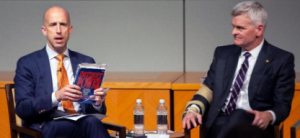
CATO INSTITUTE’S MICHAEL CANNON AND SEN. BILL CASSIDY DISCUSS THE 25TH ANNIVERSARY OF PATIENT POWER, WRITTEN BY JOHN GOODMAN AND GERALD MUSGRAVE.
A quarter century ago, the Cato Institute released a revolutionary book, Patient Power: Solving America’s Health Care Crisis, by John C. Goodman and Gerald L. Musgrave. Patient Power introduced the United States to a bold and radical way of thinking about health care.
When third parties pay medical bills, Goodman and Musgrave wrote, providers come to view third-party payers as their customers, not the patients. As a result, instead of maximizing patient satisfaction, providers deliver care to maximize their revenue given third-party payment formulas. Instead of falling, costs rise. Third-party payment is the reason patients can’t talk to their doctors by phone, email, or Skype. It is why patients don’t have Uber-type doctor house calls at night and on weekends. Patient Power showed that if people controlled and managed their own health care dollars, the medical marketplace would change radically—almost overnight.
Indeed, Patient Power changed the world. Thanks largely to Goodman and Musgrave’s work, more than 20 million people are managing their own health care dollars in health savings accounts. A roughly equal number are managing their medical spending through health reimbursement arrangements. And employers are experimenting with giving individuals complete financial control over everything from hip and knee replacements to blood tests.
The Cato event included Sen. Bill Cassidy and others.
Goodman Briefs Congressional Aides on Pre-existing Conditions
Dr. Goodman presented to an audience of congressional aides at the Heritage Foundation in June. He said the Democrats had legitimate complaints against Republican health reforms and the GOP was making a big mistake by not taking the complaints seriously.
Republicans need to make clear that they will give broad flexibility to state governments to reform their Obamacare insurance markets, provided that things get better for people with health conditions. (See the discussions of resolutions above.)
Outreach

JOHN GOODMAN AND NOBEL LAUREATE VERNON SMITH AT THE MONT PELERIN SOCIETY MEETING IN FORT WORTH.
The Goodman Institute was a sponsor of the Mont Pelerin Society meeting in Fort Worth in May. The MPS is an international organization founded by Milton Friedman, Fredrich Hayek and other advocates of individual liberty. In addition, Dr. Goodman made presentations on tax policy to the Tax Cut Working Group and to the Americans for Tax Reform. He briefed congressional staffers on health policy at the Heritage Foundation and the Consensus Group at the Hoover Institution office in DC. Prof. Kotlikoff made a presentation on tax policy to the National Tax Association and one on modeling the costs and benefits of climate change to the Environmental Protection Agency (EPA).
Writing in the Wall Street Journal, former Sen. Phil Gramm and Goodman Institute Senior Fellow Thomas Saving wrote: “Never in the Fed’s 105-year history has it had less control over market interest rates than it has today. To expect the Fed to hold interest rates above or below the market rate under these circumstances is not only naive but dangerous.” Writing in Forbes, Laurence Kotlikoff says Social Security underpaid close to 10,000 widow(er)s now over age 70 some $130 million and is underpaying each new cohort of widow(er)s reaching age 70 roughly $10 million.
Goodman Institute board member Nan Hayworth told Fox News that media bias is as bad as ever. In an article in The Hill, Prof. Kotlikoff said the new Social Security Trustees report has this bad news: the program’s unfunded liability rose by $9 trillion over the past 12 months. In a series of articles in Forbes, John Goodman explained why Health Savings Accounts top every other form of retirement saving, why employers pay too much for health insurance, what socialism in health care really looks like and what Congress should be doing to help seniors.
